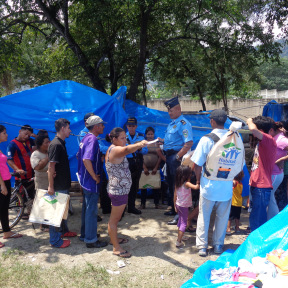Written by SALTer, Benjamin Kreider, working with the Comisión de Acción Social Menonita in San Pedro Sula, Honduras
Posted on March 8, 2016 on his personal blog.
Community members helping distribute rolls of plastic to construct temporary shelters.
The past week and a half at work we have not been in our normal rhythm of running kids activities in the bordos or holding meetings with parents. Instead we have been accompanying a group of folks who have been kicked out of their homes and have no where to go.
A week and a half ago on Wednesday a desalojo (eviction, removal) was issued for a people living in a piece of land next to one of Bordo Pedregal/Santa Ana. The Universidad Autonoma de Honduras en la Valle de Sula (UNAH-vS) through a court process, secured a police eviction notice, as they hold papers to the land. The university is planning on building a couple million-dollar complex for the engineering department.
A bulldozer about to knock down a house, note the possessions piled up outside. Each bulldozer has an armed guard.
The complex part of all of this is that folks have lived on this land for decades – some over forty or fifty years. A couple generations of folks have lived on this little piece of land – and now they were given notice that they needed to go. Those with options left first – maybe they had an apartment or family members elsewhere in the city, maybe they went to their pueblos of origin in other parts of the country – but those with means left. Others stayed back to wait and fight for the land and see what would happen. These were the folks without as many options. Eventually the police along with private security entered the community along with bulldozers (guarded by police). The bulldozers began to raze the houses of folks in the community. And so those left behind hurriedly were dismantling their houses – to save pieces of tin, wood-siding, electrical wire and their possessions. It was chaos with each person and family trying to save what they have. In end, with all the houses leveled by bulldozers, first the police in riot gear and later private security offices guarded the perimeter of the property so folks couldn’t reenter. Those without a place to go moved their possessions to the other side of the street, along the road.
After the land was cleared it was guarded by police and security guards.
So CASM as one of, possibly the only, group that works directly with in the bordos, needed to help and walk alongside these folks. Initially we provided large rolls of plastic sheeting to construct temporary shelters to protect from rain, we brought water and food. The situation is difficult and complex – folks are caught in the middle of a crisis. Families are living in make-shift shelters in the open air, ranging from babies as young as 10-days to elderly grandparents. With all the uncertainty folks can’t return to jobs with their family in crisis, kids haven’t been able to go to school. This community and each family is waiting, looking for other options, connections, a place to move, a piece of land.
I had an interesting conversation with this police officer- while he has orders to push out the families he identifies with the people, as he too grew up poor.
Directly next-door to the evicted land, or to be fair right on the other side of a high concrete-barb-wired wall, lies a wealthy neighborhood, big houses individually walled off and guarded. Just down the road from this land stands a high-rise luxury-condo, with another in progress. The disparities of wealth sit side-by-side here.
My coworker, Luisa Santos, distributing food and hygiene bags.
I was moved by the resiliency and spirit of this community that had just passed through something so traumatic – their status without homes, their houses destroyed, without a place to go. People go on with normal things – kids play soccer, electrical lines are rigged up to power fans and radios, someone strings up clotheslines to dry clothes, others make tortillas over makeshift wood stoves and cook meals to share communally, and everyone set to work building temporary shelters out of salvaged materials. People shared with me their faith and trust in God through this time – that God would provide, that they had hope that things would work out. My mind and heart couldn’t help but make the connection to scripture where God walks with people in similar situations – makeshift tents in the desert after an exodus, a young refugee couple fleeing to a foreign land with their son the Messiah, who as an adult had no where to lay his head. I pray that God continues to walk with God’s people.
Daily life resumes in a makeshift way.
All Photos by Benjamin Kreider.







